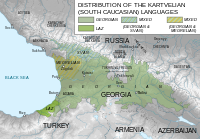Mingrelians
| Total population | |
|---|---|
| c. 400,000[1] | |
| Regions with significant populations | |
| 600 (2010)[3] | |
| Languages | |
| Mingrelian, Georgian, Russian | |
| Religion | |
| Predominantly † Eastern Orthodox Christianity (Georgian Orthodox Church) | |
| Part of a series on |
| Georgians ქართველები |
|---|
 |
| Nation |
| Georgia |
| Ancient Kartvelian people |
| Subgroups |
| Culture |
| Languages |
| Religion |
| Symbols |
| History of Georgia |
The Megrelians[4] (Megrelian: მარგალი, margali; Georgian: მეგრელები: megrelebi) are a subgroup of Georgians[5][6][7][8][9][10] that mostly live in Samegrelo region of Georgia. They also live in considerable numbers in Abkhazia and Tbilisi. In the pre-1930 Soviet census, the Megrelians were afforded their own ethnic group (natsional'nost) category.[11][12]
The Mingrelians speak the Mingrelian language, and are mostly bilingual also in Georgian. Both these languages belong to the Kartvelian language family.[13][14][15]
History



The endonym Margali (მარგალი) is presumably reflected in the Greek Manraloi (Μάνραλοι), recorded as a people of Colchis by Ptolemy in the 2nd century BC.
Early in the Middle Ages, Megrelian aristocracy and clergy, later followed by laymen, adopted the Georgian tongue as a language of literacy and culture.[citation needed] After the fragmentation of the Kingdom of Georgia in the 15th century, Mingrelia was an autonomous principality until being annexed by the Russian Empire in the 19th century.
In several censuses under the Russian Empire and the early Soviet Union, Megrelians were considered a separate group, largely because at the time of the annexation Samegrelo was politically separate from eastern Georgia, the historical political and cultural centers of the Medieval Georgian Kingdoms. They were, reclassified under the broader category of Georgian in the 1930s. Currently, most Megrelians identify themselves as a subgroup of the Georgian nation and have preserved many characteristic cultural features - including the Megrelian language - that date back to the pre-Christian Colchian era.
The first President of an independent Georgia, Zviad Gamsakhurdia (1939–1993), was a Megrelian.[16] Therefore, after the violent coup d'état of December 21, 1991 - January 6, 1992, Samegrelo became the centre of a civil war, which ended with the defeat of Gamsakhurdia's supporters.
Approximately 180,000-200,000 people of Georgian and Megrelian provenance have been expelled from Abkhazia as a result of the Georgian-Abkhaz conflict in the early 1990s and the ensuing ethnic cleansing of Georgians in this separatist region.
Notable Megrelians
- Konstantine Gamsakhurdia, one of the most influential Georgian writers of the 20th century [17]
- Zviad Gamsakhurdia, the 1st President of Georgia [16]
- Lavrentiy Beria, Stalin's chief of secret police [16]
- Merab Kostava, National Hero of Georgia [18]
- Şevkefza Sultan, Ottoman Valide Sultan
See also
Notes
- ^ a b Joshuaproject. Margaluri, Mingrelian of Georgia
- ^ Including Abkhazia, where 46,000 Megrels and Georgians
- ^ Russian census 2010
- ^ Alternately, Mingrelians, Mingrels, or Megrels
- ^ Stuart J. Kaufman Modern Hatreds: The Symbolic Politics of Ethnic War, p 86: «Additionally, the Georgian category includes an array of politically important subgroups especially Mingrelians, Svans and Ajarians»
- ^ Kevin Tuite The Meaning of Dæl. Symbolic and Spatial Associations of the South Caucasian Goddess of Game Animals. Université de Montréal.
- ^ Tunç Aybak Politics of the Black Sea: Dynamics of Cooperation and Conflict, p 185: «...Georgians (Megrels)...»
- ^ Andropov, New Challenge to the West, by Arnold Beichman, Mikhail S. Bernstam, p 116: «Georgia consists of three ethnics tribes: Imeretians, Kartvels, and Mingrelians .»
- ^ Small Nations and Great Powers: A Study of Ethnopolitical Conflict, by Svante E. Cornell, p 142
- ^ Political Construction Sites: Nation-building in Russia and the Post-Soviet World, by Pål Kolstø, p 8
- ^ R. Wixman. The Peoples of the USSR: An Ethnographic Handbook (s.134)
- ^ National population census ZSFSR 1926
- ^ Sorosoro.org
- ^ [1]
- ^ [2]
- ^ a b c McCauley, Martin. Who's who in Russia since 1900. Psychology Press, 1997: pg. 1
- ^ Rayfield, Donald. Stalin and His Hangmen: The Tyrant and Those Who Killed for Him. Random House Digital, Inc., 2005: pg. 354
- ^ Hoiris,Ole. Yurukel, Sefa. Contrasts and solutions in the Caucasus. Aarhus Univ. Press, 1998: pg.187
References
- Stephen F. Jones. Mingrelians. World Culture Encyclopedia.

